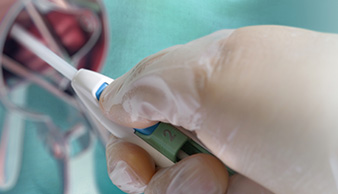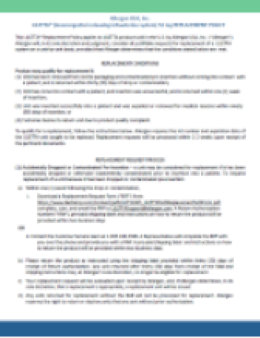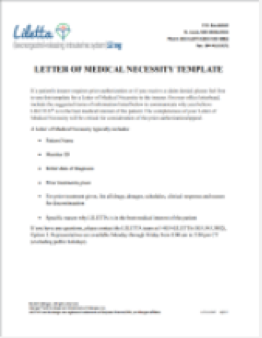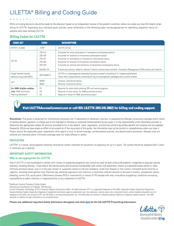LILETTA® RESOURCES FOR YOU:
ORDERING AND PRICING INFORMATION
CONTACT ALLERGAN DIRECT at 1-855-LILETTA (7AM CT to 7PM CT) for ordering and pricing information
ORDER THROUGH A SPECIALTY PHARMACY
| Specialty Pharmacy | Contact Information |
|---|---|
| Accredo® | 1.866.759.1557 |
| CVS Caremark® | 1.855.438.2574 |
LILETTA ACCESSCONNECTSM:24/7 REAL-TIME SUPPORT

Order LILETTA directly from AbbVie and manage your inventory

Gain access to patient records for on-demand results
Visit LILETTAAccessConnect.com for more information.
LILETTA PATIENT SAVINGS PROGRAM® :RESOURCES FOR YOUR ELIGIBLE PATIENTS
ELIGIBLE PATIENTS MAY BE ABLE TO SAVE ON THE LILETTA PRODUCT WITH THE LILETTA PATIENT SAVINGS PROGRAM®
Your commercially insured patients may be eligible to participate in the LILETTA Patient Savings Program®.
Patients can learn more at LILETTAcard.com.
Please note that the LILETTA Patient Savings Program® only applies to the cost of the product. It does not apply to the cost of insertion or medical examination.
*Depending on insurance coverage, eligible patients pay $100, then save up to a maximum of $750, for the first LILETTA® product. Offer applies to product only, and does not apply to costs associated with medical examination or product administration. Check with your pharmacist or healthcare provider for your copay discount. Patient out-of-pocket expense may vary. Offer not valid for patients enrolled in Medicare, Medicaid, or other federal or state healthcare programs. Please see full LILETTA Patient Savings Program® Terms, Conditions, and Eligibility Criteria here.
MEDICINES360 PARTNERSHIP: A UNIQUE COLLABORATION

AbbVie, the maker of LILETTA, and Medicines360®, a nonprofit women's health pharmaceutical organization and the developer of LILETTA, have a groundbreaking partnership to expand access to LILETTA, regardless of income or insurance coverage.
About AbbVie
- AbbVie is a global pharmaceutical company with one of the largest women's healthcare divisions in the world
- AbbVie is investing in innovative programs and solutions that facilitate access in both the public and private sectors.
- Learn more about AbbVie at abbvie.com
About Medicines360
- Medicines360 is a global nonprofit pharmaceutical company whose mission is to remove cost as a barrier to health by developing and providing affordable women's health products
- Medicines360 invests its proceeds in advocacy, education, and additional product and partnership development to further its mission in the U.S. and globally
- Learn more about Medicines360 at medicines360.org
HELP:
Purchasing:
For information regarding pricing and ordering LILETTA

Benefits Investigations:
For help with patient benefits investigations and billing and coding

LILETTA Patient Savings Program®:
For information on eligibility criteria, enrollment process, and terms and conditions
Adverse Events/Medical Information:
To report any Adverse Events or to request additional medical information on LILETTA. You may also call our direct Medical Information line at: 1.800.678.1605

Product Quality:
To report any product quality complaints
Request a Field Sales Representative:
To request a visit from a field sales representative
DOWNLOADABLE RESOURCES:
Placement
Practice
LILETTA® is a sterile, levonorgestrel-releasing intrauterine system indicated for prevention of pregnancy for up to 8 years; replace after 8 years if continued use is desired. LILETTA is indicated for the treatment of heavy menstrual bleeding (HMB) for up to 5 years in women who choose intrauterine contraception as their method of contraception; replace after 5 years if continued HMB treatment is needed.
Use of LILETTA is contraindicated in women with the following: pregnancy; for use as post-coital contraception; congenital or acquired uterine anomaly, including leiomyomas, that distorts the uterine cavity and would be incompatible with correct intrauterine system (IUS) placement; known or suspected breast cancer or other hormone-sensitive cancer, now or in the past; known or suspected uterine or cervical malignancy; acute liver disease or liver tumor; untreated acute cervicitis or vaginitis, including lower genital tract infections (eg, bacterial vaginosis), until infection is controlled; postpartum endometritis or infected abortion in the past 3 months; unexplained uterine bleeding; a current IUS; acute pelvic inflammatory disease (PID); conditions increasing susceptibility to pelvic infection; or hypersensitivity to any component of LILETTA.
Use LILETTA with caution after careful assessment in women with coagulopathy or taking anticoagulants; migraine, focal migraine with asymmetrical visual loss, or other symptoms indicating transient cerebral ischemia; exceptionally severe or frequent headache; marked increase of blood pressure; or severe arterial disease such as stroke or myocardial infarction. Consider removing LILETTA if the following arise during use: uterine or cervical malignancy or jaundice. Because irregular bleeding/spotting is common during the first months of LILETTA use, exclude endometrial pathology (polyps or cancer) prior to the insertion of LILETTA in women with persistent or uncharacteristic bleeding. If the threads are not visible or are significantly shortened, they may have broken or retracted into the cervical canal or uterus. If LILETTA is displaced (eg, expulsed or perforated the uterus), remove it.
If pregnancy should occur with LILETTA in place, remove the IUS because leaving it in place may increase the risk of spontaneous abortion and preterm labor. Removal or manipulation may result in pregnancy loss. Evaluate women for ectopic pregnancy because the likelihood of a pregnancy being ectopic is increased. Tell women about the signs of ectopic pregnancy and associated risks, including loss of fertility. Women with a history of ectopic pregnancy, tubal surgery, or pelvic infection have a higher risk of ectopic pregnancy.
Insertion of LILETTA is contraindicated in the presence of known or suspected PID or endometritis. IUSs have been associated with an increased risk of PID, most likely due to organisms being introduced into the uterus during insertion. In the LILETTA contraception study, one woman diagnosed with PID and two women diagnosed with endometritis developed the infection within a week of insertion. One endometritis case was diagnosed at 39 days after insertion. The remaining 11 cases of PID and endometritis were diagnosed more than 6 months after insertion, including one at 30 days after IUS removal. In the HMB study, one woman was diagnosed with PID about 5 months after LILETTA insertion. Counsel women who use LILETTA to notify a healthcare provider if they develop lower abdominal or pelvic pain, fever, chills, unusual or malodorous discharge, unexplained bleeding, genital lesions or sores, or dyspareunia. PID and endometritis are often associated with sexually transmitted infections (STIs); LILETTA does not protect against STIs, including HIV. PID or endometritis may be asymptomatic but still result in tubal damage and its sequelae. Inform women about the possibility of PID or endometritis and that these infections can cause tubal damage leading to ectopic pregnancy or infertility, or infrequently can necessitate hysterectomy, or cause death.
Spotting and irregular or heavy bleeding may occur during the first 3 to 6 months. Periods may become shorter and/or lighter thereafter. Cycles may remain irregular, become infrequent, or even cease. Consider pregnancy, including ectopic pregnancy, if menstruation does not occur within 6 weeks of the onset of previous menstruation. If a significant change in bleeding develops during prolonged use, conduct diagnostic tests to assess possible endometrial pathology.
Some serious complications with IUSs like LILETTA are sepsis, perforation, and expulsion. Severe infection or sepsis, including Group A streptococcal sepsis (GAS), have been reported following insertion of LNG-releasing IUSs. Aseptic technique during insertion of LILETTA is essential to minimize serious infections such as GAS.
Perforation (total or partial, including penetration/embedment of LILETTA in the uterine wall or cervix) may occur, most often during insertion, although the perforation may not be detected until sometime later. Perforation may also occur at any time during use. Perforation may reduce contraceptive efficacy. If perforation is suspected, locate and remove LILETTA as soon as possible. Surgery may be required. Delayed detection or removal of LILETTA in case of perforation may result in migration outside the uterine cavity, adhesions, peritonitis, intestinal perforations, intestinal obstruction, abscesses, and erosion of adjacent viscera. The risk of perforation is increased if inserted in women who have fixed retroverted uteri, are postpartum, or are lactating. Delay LILETTA insertion a minimum of 4 weeks or until uterine involution is complete following a delivery or a second-trimester abortion.
Partial or complete expulsion of LILETTA may occur, resulting in the loss of contraceptive protection. Expulsion risk is increased when inserted immediately after delivery; it appears to be increased with insertions after second-trimester abortion, based on limited data. Risk of expulsion is increased for patients with a history of HMB or greater than normal BMI at the time of insertion. Remove a partially expelled LILETTA. If expulsion has occurred, a new LILETTA may be inserted when there is reasonable certainty the patient is not pregnant.
Ovarian cysts may occur and are generally asymptomatic. Cysts may be accompanied by pelvic or abdominal pain or dyspareunia. Evaluate persistent ovarian cysts.
In the LILETTA contraception study, the most common adverse reactions (≥5% users) were vulvovaginal mycotic infections (20.2%), vaginal bacterial infections (19.2%), acne (15.5%), nausea or vomiting (10.5%), headache (10.1%), breast tenderness or pain (10.1%), abdominal discomfort or pain (10.0%), dyspareunia (9.6%), anxiety (9.6%), depression (9.1%), pelvic discomfort or pain (8.7%), dysmenorrhea (7.3%), mood changes (6.5%), back pain (6.5%), increased weight (6.1%), and vaginal discharge (5.8%). In the LILETTA HMB study, the adverse reaction profile was consistent with the adverse reaction profile in the contraception study.
Teach patients to recognize and immediately report signs or symptoms of the aforementioned conditions. Consider evaluating patients 4 to 6 weeks after LILETTA insertion and during routine care, or more often if clinically indicated. Check threads during each evaluation.
Please see full Prescribing Information
References: 1. LILETTA (levonorgestrel-releasing intrauterine system) 52 mg [prescribing information]. North Chicago, IL: AbbVie Inc., and San Francisco, CA: Medicines360. 2. Data on file. ABVRRTI75507. 3. Data on file. ABVRRTI75116. 4. Data on file. ABVRRTI75429. 5. Creinin MD et al. Obstet Gynecol. 2023;14(5):971-978.
Use of LILETTA is contraindicated in women with the following: pregnancy; for use as post-coital contraception; congenital or acquired uterine anomaly, including leiomyomas, that distorts the uterine cavity and would be incompatible with correct intrauterine system (IUS) placement; known or suspected breast cancer or other hormone-sensitive cancer, now or in the past; known or suspected uterine or cervical malignancy; acute liver disease or liver tumor; untreated acute cervicitis or vaginitis, including lower genital tract infections (eg, bacterial vaginosis), until infection is controlled; postpartum endometritis or infected abortion in the past 3 months; unexplained uterine bleeding; a current IUS; acute pelvic inflammatory disease (PID); conditions increasing susceptibility to pelvic infection; or hypersensitivity to any component of LILETTA.
Use LILETTA with caution after careful assessment in women with coagulopathy or taking anticoagulants; migraine, focal migraine with asymmetrical visual loss, or other symptoms indicating transient cerebral ischemia; exceptionally severe or frequent headache; marked increase of blood pressure; or severe arterial disease such as stroke or myocardial infarction. Consider removing LILETTA if the following arise during use: uterine or cervical malignancy or jaundice. Because irregular bleeding/spotting is common during the first months of LILETTA use, exclude endometrial pathology (polyps or cancer) prior to the insertion of LILETTA in women with persistent or uncharacteristic bleeding. If the threads are not visible or are significantly shortened, they may have broken or retracted into the cervical canal or uterus. If LILETTA is displaced (eg, expulsed or perforated the uterus), remove it.
If pregnancy should occur with LILETTA in place, remove the IUS because leaving it in place may increase the risk of spontaneous abortion and preterm labor. Removal or manipulation may result in pregnancy loss. Evaluate women for ectopic pregnancy because the likelihood of a pregnancy being ectopic is increased. Tell women about the signs of ectopic pregnancy and associated risks, including loss of fertility. Women with a history of ectopic pregnancy, tubal surgery, or pelvic infection have a higher risk of ectopic pregnancy.
Insertion of LILETTA is contraindicated in the presence of known or suspected PID or endometritis. IUSs have been associated with an increased risk of PID, most likely due to organisms being introduced into the uterus during insertion. In the LILETTA contraception study, one woman diagnosed with PID and two women diagnosed with endometritis developed the infection within a week of insertion. One endometritis case was diagnosed at 39 days after insertion. The remaining 11 cases of PID and endometritis were diagnosed more than 6 months after insertion, including one at 30 days after IUS removal. In the HMB study, one woman was diagnosed with PID about 5 months after LILETTA insertion. Counsel women who use LILETTA to notify a healthcare provider if they develop lower abdominal or pelvic pain, fever, chills, unusual or malodorous discharge, unexplained bleeding, genital lesions or sores, or dyspareunia. PID and endometritis are often associated with sexually transmitted infections (STIs); LILETTA does not protect against STIs, including HIV. PID or endometritis may be asymptomatic but still result in tubal damage and its sequelae. Inform women about the possibility of PID or endometritis and that these infections can cause tubal damage leading to ectopic pregnancy or infertility, or infrequently can necessitate hysterectomy, or cause death.
Spotting and irregular or heavy bleeding may occur during the first 3 to 6 months. Periods may become shorter and/or lighter thereafter. Cycles may remain irregular, become infrequent, or even cease. Consider pregnancy, including ectopic pregnancy, if menstruation does not occur within 6 weeks of the onset of previous menstruation. If a significant change in bleeding develops during prolonged use, conduct diagnostic tests to assess possible endometrial pathology.
Some serious complications with IUSs like LILETTA are sepsis, perforation, and expulsion. Severe infection or sepsis, including Group A streptococcal sepsis (GAS), have been reported following insertion of LNG-releasing IUSs. Aseptic technique during insertion of LILETTA is essential to minimize serious infections such as GAS.
Perforation (total or partial, including penetration/embedment of LILETTA in the uterine wall or cervix) may occur, most often during insertion, although the perforation may not be detected until sometime later. Perforation may also occur at any time during use. Perforation may reduce contraceptive efficacy. If perforation is suspected, locate and remove LILETTA as soon as possible. Surgery may be required. Delayed detection or removal of LILETTA in case of perforation may result in migration outside the uterine cavity, adhesions, peritonitis, intestinal perforations, intestinal obstruction, abscesses, and erosion of adjacent viscera. The risk of perforation is increased if inserted in women who have fixed retroverted uteri, are postpartum, or are lactating. Delay LILETTA insertion a minimum of 4 weeks or until uterine involution is complete following a delivery or a second-trimester abortion.
Partial or complete expulsion of LILETTA may occur, resulting in the loss of contraceptive protection. Expulsion risk is increased when inserted immediately after delivery; it appears to be increased with insertions after second-trimester abortion, based on limited data. Risk of expulsion is increased for patients with a history of HMB or greater than normal BMI at the time of insertion. Remove a partially expelled LILETTA. If expulsion has occurred, a new LILETTA may be inserted when there is reasonable certainty the patient is not pregnant.
Ovarian cysts may occur and are generally asymptomatic. Cysts may be accompanied by pelvic or abdominal pain or dyspareunia. Evaluate persistent ovarian cysts.
In the LILETTA contraception study, the most common adverse reactions (≥5% users) were vulvovaginal mycotic infections (20.2%), vaginal bacterial infections (19.2%), acne (15.5%), nausea or vomiting (10.5%), headache (10.1%), breast tenderness or pain (10.1%), abdominal discomfort or pain (10.0%), dyspareunia (9.6%), anxiety (9.6%), depression (9.1%), pelvic discomfort or pain (8.7%), dysmenorrhea (7.3%), mood changes (6.5%), back pain (6.5%), increased weight (6.1%), and vaginal discharge (5.8%). In the LILETTA HMB study, the adverse reaction profile was consistent with the adverse reaction profile in the contraception study.
Teach patients to recognize and immediately report signs or symptoms of the aforementioned conditions. Consider evaluating patients 4 to 6 weeks after LILETTA insertion and during routine care, or more often if clinically indicated. Check threads during each evaluation.
LILETTA® is a sterile, levonorgestrel-releasing intrauterine system indicated for prevention of pregnancy for up to 8 years; replace after 8 years if continued use is desired. LILETTA is indicated for the treatment of heavy menstrual bleeding (HMB) for up to 5 years in women who choose intrauterine contraception as their method of contraception; replace after 5 years if continued HMB treatment is needed.
Please see full Prescribing Information.

52mg-logo-image-mobile.png)
















